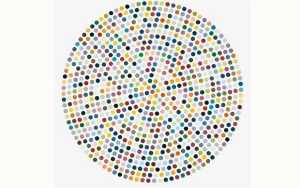Taking potshots at the Damien Hirst Complete Spot Paintings, 1986 – 2011 exhibition has become the sport of the day, and I’m not one to disagree. I find them simply boring. They fared poorly in a test of what visitors view, too.
That doesn’t mean there’s nothing to say about them, though.
 First off, despite the breadth of works shown around the world, these are not the “complete” spot paintings. Hirst has taken credit for about 1,400 of them, and only 331 are on view in this global exhibition. About half of those on view are for sale, with the rest borrowed.
First off, despite the breadth of works shown around the world, these are not the “complete” spot paintings. Hirst has taken credit for about 1,400 of them, and only 331 are on view in this global exhibition. About half of those on view are for sale, with the rest borrowed.
How many do you think Hirst painted himself? True, we all know that he employs a battalion of workers to paint for him, but this article, in London’s Daily Mail, reveals it all for us: Hirst actually painted only five of the spot paintings. Hirst, according to the Daily Telegraph, evaded the question when he was asked to confirm or dispute the figure.
The Telegraph refers to an interview Hirst did with Reuters, in which “Hirst claimed that ‘every single spot painting contains my eye, my hand and my heart. I imagine you will want to say that if I don’t actually paint them myself then how can my hand be there? But I controlled every aspect of them coming into being and much more than just designing them or even ordering them over the phone. And my hand is evidence in the paintings everywhere.’ ”
And what does Hirst tell his army of workers? According to Blake Gopnik, writing in Newsweek, “One rule Hirst gives the assistants who execute these works is that no color can repeat in any single piece. Another is that the gaps must be the same size as the spots.”
Art in America‘s January issue provides a few interesting “Spot Stats,” namely that the largest is 10 by 40 ft. and can be seen in London/Britannia St., the smallest is 1 by 1.5 inches at Davies St. in London, the earliest — from 1986 — is on Madison Ave. in New York and the “spottiest” is “in progress” and will feature 1 million spot.
They show no sign of going away, but why would they?
As Richard Dorment wrote in the Telegraph,
They are perfect corporate artworks, ideal for banks, board rooms, and modernist collectors who have no particular knowledge or taste. Cheerful but not cheap, you don’t have to look at them for more than a second or two to get the point. The fact that every corporate collection in the world has one is also a plus. It’s like knowing everyone else at the Tate Modern opening is wearing an Armani suit. Their suit may not be exactly like yours, but you know you are dressed correctly because it’s Armani.
The ctitical views I’ve read have not much disagreed.
Meantime, Larry Gagosian profits from this totally over-hyped, gallery around-the-world exhibition.
Photo Credit: Zinc Sulfate, 2008, Courtesy of Gagosian Galleries
